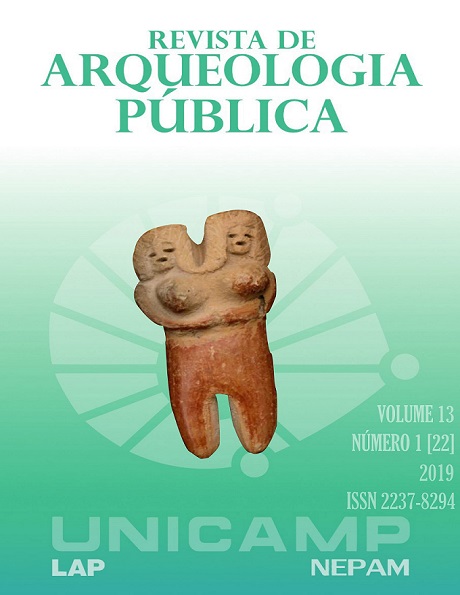Resumo
O presente artigo propõe uma análise a respeito do modo Discovery Tour, desenvolvido pela Ubisoft Montreal para o jogo Assassin’s Creed Origins. O Discovery Touré proposto pelos desenvolvedores como uma ferramenta “puramente educacional”, entendida como um “Museu Virtual” auxiliando alunos na compreensão do passado por meiodetoursguiados e a exploração de sítios históricos. Problematiza-se neste estudo a censura realizada às estátuas do mundo Greco-Romano, uma vez que essas aparecem neste –e somente neste –modo de jogo com seios e genitálias cobertas por conchas, levantando-se questões acerca do ensino e o olhar sexualizado sobre o passado.
Referências
ALVES, Luciana; BIANCHIN, Maysa. O Jogo como Recurso de Aprendizagem. Revista Psicopedagogia, São Paulo, v. 27, n. 83, p. 282-287, 2010.
BARBIERI, Loris; BRUNO, Fabio; MUZZUPAPPA, Maurizio. Virtual museum system evaluation through user studies. Journal of Cultural Heritage, v. 26, p. 101–108. 2017.
BEIER-DE HAAN, Rosmarie. Re-Staging Histories and Identities. In: Macdonald, Sharon. (Ed.) A Companion to Museum Studies. Oxford: Blackwell Publishing, p. 186-198, 2006.
BERRY, David. Understanding Digital Humanities. New York: Palgrave Macmillan, 2012.
BOARDMAN, John. Greek Sculpture: The Archaic Period. London: Thames and Hudson, 1996.
BOARDMAN, John. Greek Sculpture: The Classical Period. London: Thames and Hudson, 1995.
BOARDMAN, John. Greek Sculpture. The Late Classical Period. London: Thames and Hudson, 1995.
BRUNO, Cristina. Museus, identidades e patrimônio cultural. Revista do Museu de Arqueologia e Etnologia. Suplemento 7. São Paulo, 2008, p. 145-151.
BUTLER, Judith. Gender Trouble. New York; London: Routledge. 1990.
CLARK, Jeffrey. The Fallacy of Reconstruction In: FORTE, Maurizio. (Ed.). CyberArchaeology. Oxford: Archaeopress, BAR v. 2177, p. 63-74, 2010.
COVER, Rob. The Naked Subject, Context and Sexualization in Contemporary Culture. In: Body & Society, v. 9. n. 3, London; Thousand Oaks; New Dehli: Sage Publications, 2003, p. 53-71.
FOUCAULT, Michel. História da Sexualidade: O Cuidado de Si. v 3. Rio de Janeiro: Edições Graal, 1985.
INSOLL, Timothy. Introduction: configuring identities in archaeology. In: INSOLL, Timothy (ed.). The Archaeology of Identities: A Reader. London; New York: Routledge, 2007, p. 1-18.
MCCALL, Jeremiah. Teaching History with Digital Historical Games: An Introduction to the Field and Best Practices. In: Sage, v. 47, n. 4, p. 1-26, 2016.
MCMICHAEL, Andrew. PC Games and the Teaching of History. In: The History Teacher, v. 40, n. 2, p. 203-218, 2007.
MOSCHINI, Rosanita; CAIERÃO, Iara. O Brincar na Clínica Psicopedagógica. Revista Psicopedagogia, São Paulo, v. 32, n. 99, p. 361-365, 2015.
MPAA. Classification and Rating Rules. Sherman Oaks & Washington: 2010.
PIVEC, Maja; KRONBERGER, Anika. Virtual Museum: Playful Visitor Experience in the Real and Virtual World. 8th International Conference on Games and Virtual Worlds for Serious Applications (VS-GAMES), 2016. p. 1-4.
SANTOS, Dominique. De tablet para tablet ‐ novas ferramentas para a pesquisa e o ensino
da história das culturas cuneiformes na era digital. Revista Tempo e Argumento, Florianópolis, v. 6, n. 12, p. 212 ‐ 241, mai./ago. 2014.
SCHREIBMAN, Susan; SIEMENS, Raymond; UNSWORTH, John (eds.). A companion to Digital Humanities. Malden; Oxford; Victoria: Blackwell Publishing, 2004.
SCHWEIBENZ, Werner. The Development of Virtual Museums. ICOM News, v. 57, n. 3, p. 3. 2004.
SHANKS, Michael; TILLEY, Christopher. Reconstructing Archaeology: theory and practice. Cambridge, Cambridge University Press, 1992.
SMITH, Roland. Hellenistic Sculpture. London: Thames & Hudson World of Art, 2005.
TAHINCI, Anna. Removing the feags leaf: todays Nudity in the American Public Eye. Sculpture Review. v. 57, n. 2 p. 16-23, 2008.
VOUT, Caroline. Sex on Show: Seeing the Erotic in Greece and Rome. London: British Museum Press, 2013.
The Guardian. Disponível em: https://www.theguardian.com/technology/2017/oct/05/assassins-creed-originsrecreated-ancient-egypt-ubisoft. Acesso em: 25. 04. 2019.
ICOM - International Council of Museums. Disponível em: https://icom.museum/en/. Acesso em: 16. 02. 2019.
Ubisoft. Disponível em: https://support.ubi.com/en-gb/Faqs/000031846/Discovery-Tour-Mode-of-Assassins-Creed-Origins-ACO. Acesso em: 25. 04. 2019.
PC Games News (PCGamesN). Disponível em: https://www.pcgamesn.com/assassins-creed-origins/assassins-creed-originsdiscovery-tour-nude-statues-censorship. Acesso em: 20. 02. 2019.
Schnapp, J. and Presner, P. Digital Humanities Manifesto 2.0., 2009.
Smithsonian. Disponível em: https://www.smithsonianmag.com/arts-culture/true-colors17888/?c=y&page=3, Acesso em: 26. 02. 2019.
A Revista Arqueologia Pública utiliza a licença do Creative Commons (CC), preservando assim, a integridade dos artigos em ambiente de acesso aberto.


